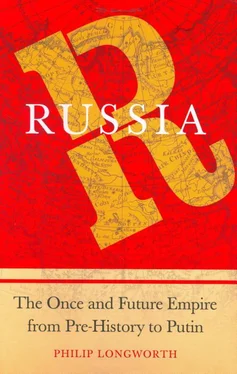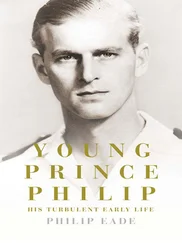Inside the palace, plume-helmeted guardsmen punctuated the spaces, and there were astonishing things to see: clockwork metal songbirds that sang like real birds; a pair of gilded lions which rolled their eyes and roared; a throne harnessed to hydraulic power which could lift the Emperor to the ceiling of his audience chamber, making him appear godlike to people beneath. The court protocol was elaborate, with much pomp and many formalities. Some 400 years earlier the wife of the Emperor Justinian — Theodora — had been both influential and visible, but subsequently the Christian Church had whittled away much of the women’s former privileges and freedom. As a result, women were less visible and less powerful than they had once been — even well-regarded women whom the Emperor was wooing. Empresses were still important, but their formal engagements proceeded for the most part separately from those of the men. And so Olga was entertained by the Empress to a separate dinner, though held at the same time as the Emperor’s, and only met the Emperor informally, when he visited the Empress and the imperial children in their quarters.
But the grandeur and exotic unfamiliarity of court life could hardly have been lost on Olga. Even informal meals would be taken at a golden table, though diners reclined on couches in the old Roman style. The food served was wonderfully different. The cooking — based on olive oil — featured not only familiar fish, meats and fowl, mushrooms, apples and honey, but unfamiliar aubergines, figs and pomegranates, anchovies and calamari. Ingredients were transformed by unfamiliar spices, wine marinades, exotic stuffings and amazing creations of filo pastry. And Olga would have learned to cope with small unfamiliar eating implements made of ivory and precious metal rather than tearing the meats placed before her with her fingers or her teeth. 17
Most impressive of all, though, was the Church of the Holy Wisdom, or Santa Sophia. Inside this splendid pile with its immense dome, built by Justinian four centuries or so before, were mosaic portraits of emperors, saints and archangels attending the figure of Jesus and, high above this, a magisterial depiction of God the Father. Through this huge space, crowded with worshippers, came black-cowled deacons swinging censers of pungent incense. Priests and bishops in richly patterned vestments followed — and then choirs struck up, echoing each other’s ethereal music from all directions. Like so many other newcomers to the experience, even the hard-headed Olga must have wondered for some moments whether she was in heaven or on earth. 18
The chronicles present Olga as a pious candidate for sainthood. Yet, amazed though she must have been by the unimaginable wealth and strange beauty of it all, her actions suggest that she remained a calculating, political woman. To understand the Russians’ conversion one must discount the tales about Olga’s piety and recognize the deeply political nature of her choice. She knew the Byzantine Church had competitors, and she was to use the German Church as a lever to get what she wanted. She well understood the implications conversion would have for Russian princely power. She learned that the Christian Church, administered by the Patriarch of Constantinople (who also received her), worked ‘in symphony’ with the emperor and helped the secular authorities in many ways — as spiritual arm, moral authority, provider of social services, and mobilizer of the Christian populations. She also observed the effectiveness of Christianity in holding the people in thrall.
Olga is reckoned to have become a Christian before going to Constantinople, indeed to have had a priest in her retinue when she went. Nevertheless, she decided to be baptized there again, this time in a more political way, with the Emperor himself serving as her godfather at a carefully orchestrated ceremony which gave her a new name: Helen. Helen had been the mother of the first Christian emperor, Constantine the Great, so an analogy was suggested: Olga/Helen as mother of a new Russian state. And the memory of Olga was later to suggest a link between ancient Rome and the no less extensive Russian Empire of the future.
However, Olga had gone to Constantinople to negotiate better trading terms, and in this she was evidently disappointed, because shortly after her return to Kiev she sent an embassy to the German king, Otto I, asking him to send her a bishop and priests. She knew very well that, though Christendom was formally united, there were three competing Christian organizations, each with its own traditions, and that the German Church, though under the Pope, was effectively owned by the prince who had power of ecclesiastical appointments. Such power was an attractive option, but Olga used her flirtation with the Germans as a warning to Byzantium. When the Emperor became more accommodating, the German bishop was sent away. 19
Olga’s visit inspired a desire to re-create in her own land some of the wonders she had seen. It also encouraged an expansion of Byzantine missionary activity among the Russians, and established a conduit through which cultural influences began to flow. Byzantine designs and Byzantine artisans penetrated Russia in increasing numbers, and some Russians even began to hanker after literacy — for missionaries had invented an alphabet to represent the sounds that Slavonic-speaking peoples made when they spoke. Invented for the Balkan Slavs, it was to serve the Russians equally well, for, as Constantine VII recorded, all Slavs, whether in the east, west or south, spoke the same language at that time.
Yet Olga/Helen’s personal commitment to Christianity did not imply the Christianizatio of Russia. The opposition was far too strong for that. Most Rus were addicted to their own gods — gods who represented the forces of nature. Christianity, with its faith in the Son of God, who suffered to save the whole community and was resurrected every year, had undoubted attractions. But it could not easily replace the familiar sprites that had power over woods and streams. And was the Christian god as powerful as, say, Perun, the god of thunder, bringer of rain and of prosperity, by whom Russians swore their most solemn oaths? How could the memory of a crucifixion be as effective as the sacrifice of human beings in propitiating a god? And would these chanting black-garbed foreign priests be as effective as the Rus shamans in their magic clothes sewn with tinkling bells? Whatever their personal preferences, Olga and her successors had to take account of their subjects’ feeling if they were to survive.
The Christian priests who came to Russia were persuasive missionaries. They intoned the liturgy in fine voices, learned the local vernacular, and were able to relate and explain the stories of the Bible, the significance of every feast and fast day, and the merits of every saint in their calendar with reference to powerful and captivating visual aids called icons. Above all, they spread a vision of hell and the prospect of bliss through salvation. They also exploited the advantages of superior technology, bringing bigger, more resounding bells with them, and incense that smelled stronger and more interesting than the shamans’ concoctions. The number of Christian converts increased steadily. Yet, as more Rus became Christians, divisions and conflicts arose.
Resistance to the new religion was fed by interest as well as by affection for the familiar. Christianity threatened the shamans with loss of power and social standing, and also loss of income. Moreover, many members of the ruling elite were themselves pagans or were cautious enough not to alienate the people of their district by challenging their gods. Olga/Helen, though a Christian herself, dared not proclaim Christianity to be the religion of her people. That fateful step was to be taken by her grandson Vladimir some twenty years after Olga’s death. Meanwhile her son Sviatoslav ruled, a determined warrior and a pagan.
Читать дальше





![Stephan Orth - Behind Putin's Curtain - Friendships and Misadventures Inside Russia [aka Couchsurfing in Russia]](/books/415210/stephan-orth-behind-putin-s-curtain-friendships-a-thumb.webp)





